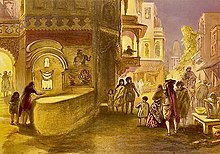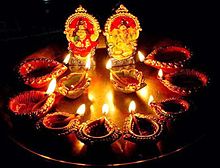Diwali
[14][15] Diwali is connected to various religious events, deities and personalities, such as being the day Rama returned to his kingdom in Ayodhya with his wife Sita and his brother Lakshmana after defeating the demon king Ravana.[17] Other regional traditions connect the holiday to Vishnu, Krishna, Durga, Shiva, Kali, Hanuman, Kubera, Yama, Yami, Dhanvantari, or Vishvakarman.[24][42] The term is derived from the Sanskrit words dīpa, 'lamp, light, lantern, candle, that which glows, shines, illuminates or knowledge'[43] and āvali, 'a row, range, continuous line, series'.[52][53] The diyas (lamps) are mentioned in Skanda Kishore Purana as symbolising parts of the sun, describing it as the cosmic giver of light and energy to all life and which seasonally transitions in the Hindu calendar month of Kartik.[54][55] Emperor Harsha refers to Deepavali, in the 7th-century Sanskrit play Nagananda, as Dīpapratipadotsava (dīpa = light, pratipadā = first day, utsava = festival), where lamps were lit and newly engaged brides and grooms received gifts.In his 11th-century memoir on India, the Persian traveller and historian Al Biruni wrote of Deepavali being celebrated by Hindus on the day of the New Moon in the month of Kartika.[58] The Venetian merchant and traveller Niccolò de' Conti visited India in the early 15th-century and wrote in his memoir, "on another of these festivals they fix up within their temples, and on the outside of the roofs, an innumerable number of oil lamps... which are kept burning day and night" and that the families would gather, "clothe themselves in new garments", sing, dance, and feast.[59][60] The 16th-century Portuguese traveller Domingo Paes wrote of his visit to the Hindu Vijayanagara Empire, where Dipavali was celebrated in October with householders illuminating their homes, and their temples, with lamps.[64][65][e][f] Publications from the time of the British Raj also made mention of Diwali, such as the note on Hindu festivals published in 1799 by Sir William Jones, a philologist known for his early observations on Sanskrit and Indo-European languages.Sanskrit inscriptions in stone and copper mentioning Diwali, occasionally alongside terms such as Dipotsava, Dipavali, Divali and Divalige, have been discovered at numerous sites across India.[75][76] Another early 13th-century Sanskrit stone inscription, written in the Devanagari script, has been found in the north end of a mosque pillar in Jalore, Rajasthan evidently built using materials from a demolished Jain temple.[54][82] Along with Lakshmi, who is representative of Vaishnavism, Ganesha, the elephant-headed son of Parvati and Shiva of Shaivism tradition, is remembered as one who symbolises ethical beginnings and the remover of obstacles.[86][87] Trade and merchant families and others also offer prayers to Saraswati, who embodies music, literature and learning and Kubera, who symbolises book-keeping, treasury and wealth management.[93] Diwali is celebrated by Hindus, Jains, Sikhs, and Newar Buddhists,[2] although for each faith it marks different historical events and stories, but nonetheless the festival represents the same symbolic victory of light over darkness, knowledge over ignorance, and good over evil.Nirvana is considered to be the state of a soul when it escapes from the cycle of birth and death, while experiencing its true nature of boundless bliss and infinite knowledge.[102] Sikhs celebrate Bandi Chhor Divas in remembrance of the release of Guru Hargobind from the Gwalior Fort prison by the Mughal emperor Jahangir and the day he arrived at the Golden Temple in Amritsar.[2] In the lead-up to Diwali, celebrants prepare by cleaning, renovating, and decorating their homes and workplaces with diyas (oil lamps) and rangolis (colourful art circle patterns).[111] During Diwali, people wear their finest clothes, illuminate the interior and exterior of their homes with saaki (earthen lamp), diyas and rangoli, perform worship ceremonies of Lakshmi, the goddess of prosperity and wealth,[m] light fireworks, and partake in family feasts, where mithai (sweets) and gifts are shared.[10] According to Goldstein, these are then shaped into various forms, such as laddus, barfis, halwa, kachoris, shrikhand, and sandesh, rolled and stuffed delicacies, such as karanji, shankarpali, maladu, susiyam, pottukadalai.Confectioners and shops create Diwali-themed decorative displays, selling these in large quantities, which are stocked for home celebrations to welcome guests and as gifts.Unlike some other festivals, the Hindus typically do not fast during the five-day long Diwali including Lakshmi Pujan, rather they feast and share the bounties of the season at their workplaces, community centres, temples, and homes.[135] At dusk, family members gather for the Lakshmi Pujan,[135] although prayers will also be offered to other deities, such as Ganesha, Saraswati, Rama, Lakshmana, Sita, Hanuman, or Kubera.[n] Contemporary Bengali celebrations mirror those found elsewhere, with teenage boys playing with fireworks and the sharing of festive food with family, but with the Shakti goddess Kali as the focus.[141][61] While the cleaning, or painting, of the home is in part for goddess Lakshmi, it also signifies the ritual "reenactment of the cleansing, purifying action of the monsoon rains" that would have concluded in most of the Indian subcontinent.[141] Vaishnava families recite Hindu legends of the victory of good over evil and the return of hope after despair on the Diwali night, where the main characters may include Rama, Krishna, Vamana or one of the avatars of Vishnu, the divine husband of Lakshmi.[149] In Gujarat, Annakut is the first day of the new year and celebrated through the purchase of essentials, or sabras (literally, "good things in life"), such as salt, offering prayers to Krishna and visiting temples.[165][166] According to Rao, Diwali is one of the major festivals where rural Indians spend a significant portion of their annual income, and is a means for them to renew their relationships and social networks.[174] Diwali has increasingly attracted cultural exchanges, becoming occasions for politicians and religious leaders worldwide to meet Hindu or Indian origin citizens, diplomatic staff or neighbours.[177][178] Additionally, cities across the UK show support of the celebrations through Diwali lights, decorations, and cultural festivities such as dance performances, food stalls and workshops.After firing, the fine dust particles get settled on the surrounding surfaces which are packed with chemicals like copper, zinc, sodium, lead, magnesium, cadmium and pollutants like oxides of sulfur and nitrogen.













Deepavali (disambiguation)RangoliHindusBuddhistsNewar BuddhistssweetsDhanterasNaraka ChaturdashiKukur TiharLakshmi PujaKali PujaGovardhan PujaBalipratipadaMha PujaBhai DoojVishwakarma PujaGujarati New YearDiwali (Jainism)Bandi Chhor DivasSwantiSohraiBandnaHindu calendarHinduismMythologyOriginsHistoryIndus Valley CivilisationVedic HinduismDravidian folk religionŚramaṇaTribal religions in IndiaItihasa-PuranaEpic-Puranic royal genealogiesEpic-Puranic chronologySampradaya (Traditions)VaishnavismPancharatraShaivismKapalikaPashupataPratyabhijñaShaktismSmartismOther Sampradaya (Traditions)DeitiesAbsolute Reality / Unifying ForceBrahmanTrimurtiBrahmaVishnuTrideviSaraswatiLakshmiParvatiTridashaAdityasRudrasAshvinsMahadeviOther Vedic DeitiesAvatarDashavataraNavadurgaMahavidyaKartikeyaGaneshaHanumanShaktiDevatasVishvakarmaKuberaConceptsCosmologyTattvasSubtle elementsPanchikaranaGross elementsGuṇasPurushaPrakṛtiSupreme realityNirgunaSagunaSaccidānandaIshvaraGod in HinduismGod and genderPuruṣārtha (Meaning of life)DharmaMokshaĀśrama (Stages of life)BrahmacharyaGṛhasthaVānaprasthaSannyasaThree paths to liberationBhakti yogaJnana yogaKarma yogaLiberationParamātmanSaṃsāraĀtman (self)Anātman (non-self)Sūkṣma śarīra (subtle body)Antaḥkaraṇa (mental organs)Prajña (wisdom)Ānanda (happiness)Viveka (discernment)Vairagya (dispassion)Sama (equanimity)Uparati (self-settledness)Titiksha (forbearance)Shraddha (faith)Samadhana (concentration)Arishadvargas (six enemies)Ahamkara (attachment)NiyamaAhimsaAchouryaAparigrahaAkrodhaArjavaSantoshaSvādhyāya